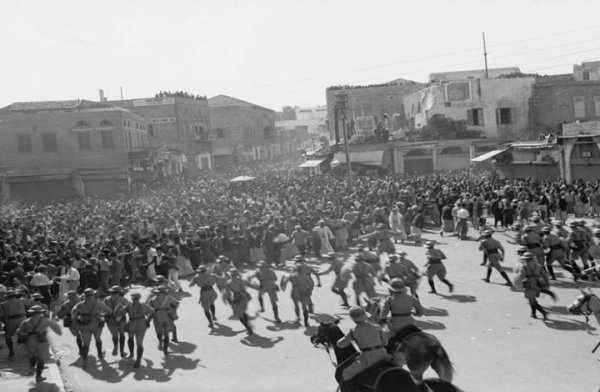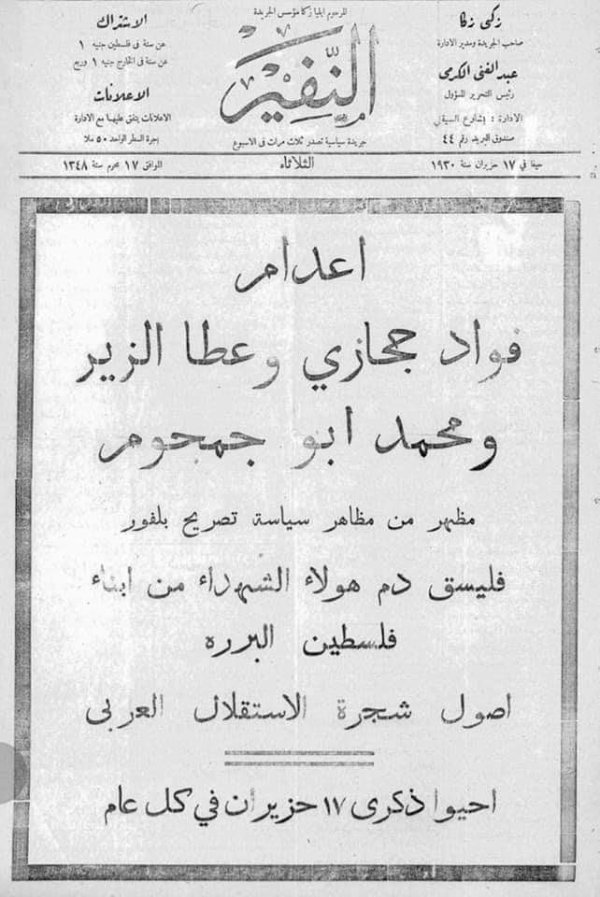
"The Barq Revolution" marked the first Palestinian uprising against the attempt to Judaize Jerusalem during the British Mandate. Widespread clashes erupted between Arabs and Jews at the Wailing Wall (the Western Wall of the Al-Aqsa Mosque) on August 15, 1929, reaching its peak on August 23, 1929, resulting in the deaths and injuries of dozens of people.
Al-Buraq is part of the Western Wall of the noble Jerusalem sanctuary. The Jewish claim of ownership over it was a cause of tension that led to violent disturbances in August 1929 between Arabs and Jews in Jerusalem and various parts of Palestine, known as the Al-Buraq Revolution.
Dated back to 1929, the Al-Buraq Revolution is considered the first major popular uprising against the Zionist project in Palestine. While preceding it were several uprisings, protests, and popular movements against British occupation and Zionist presence, the 'Al-Buraq Revolution' was a significant milestone in shaping Palestinian and Arab awareness of the dangers of Zionist schemes and the role of British Mandate authorities in the Judaization of Palestine, contributing to the construction of Palestinian national identity.
The Spark of the Outburst
On that date, which corresponds to what the Jews call the anniversary of the 'destruction of the Temple,' the extremist Zionist movement, Betar, organized a march in Jerusalem. Large numbers of Jews gathered, headed towards the Western Wall, shouting 'The Wall is Ours' and singing the Zionist movement's anthem.
Palestinians rallied to defend Al-Aqsa on the following day, coinciding with the celebration of the Prophet Muhammad's birth. They marched in a massive demonstration from the mosque towards the Wall, sparking violent clashes that spread to cities and villages across Palestine.
During the Ottoman rule, Jews were allowed to perform their rituals near the Wall. An unwritten agreement between the Islamic Waqf administration and Jews stipulated that Jews would not build anything near the Wall or place anything in its courtyard. This agreement persisted for several years.
The British Mandate authorities, who inherited the administration of Palestine after World War I, maintained the existing situation in the holy sites. However, since the decline of Ottoman rule, Jews have been attempting to change the status quo of the holy places. Their aim has been to establish Jewish control over the Noble Sanctuary in Jerusalem.
The clashes expanded to include other Palestinian cities, reaching from Hebron and Beersheba in the south to Safed in the north. After days of upheaval, a relative calm began to prevail in Palestine.
Shaw Committee:
Following the events that occurred in Jerusalem, the British mandate authorities referred to the League of Nations (United Nations) in response to the recommendation of the Shaw Committee, established by the British government to investigate the events. The committee consisted of three non-British members, chaired by former Swedish Foreign Minister Algot Bagge Walleberg, and Swiss Charles Bard, former Vice President of the International Court of Justice. After conducting the investigation, the committee presented a report in 1930 to the League of Nations.
The committee affirmed the right of Muslims to the Western Wall, stating that it is an integral part of the area of the holy sanctuary. It confirmed that the ownership of the pavement in front of the Western Wall and the area opposite the wall known as the Maghrebi Quarter belongs to Muslims. The committee decided that Jews are not allowed to bring or place religious tools, seats, carpets, chairs, curtains, barriers, or any tent near the wall, as it is considered Muslim property.
The Consequences of the Revolution
● The emergence of the Palestinian flag was witnessed when the "Palestine" newspaper proposed the necessity of adopting a flag and also called for a national anthem. This suggestion opened the door to subsequent discussions, eventually leading to the design of the Palestinian flag and other steps in the Palestinian national identity.
● The British Mandatory authorities arrested around 900 Palestinians and incarcerated them in prisons. The British courts in Palestine issued death sentences for twenty Arabs, later commuted to life imprisonment, except for three individuals: Ata al-Zeer, Mohammed Jamjoum, and Fuad Higazi. They faced the gallows in the prison of Acre, known as "the Citadel," on June 17, 1930, displaying courage immortalized by the poet Ibrahim Touqan in his poignant poem "The Red Tuesday." They were also commemorated in the popular song "A Funeral Emerged from Acre Prison."
● As for the Jews, only one of them was sentenced to death, later reduced to ten years, and he was released after a short period.
● The events of the "Buraq Revolution" led to the death of 133 Jewish individuals and 339 injuries, while the number of Arab martyrs reached 116, with 232 wounded, according to the report of the "Shaw Commission," which acknowledged that most of the Arab injuries were caused by the British forces.
● The revolution proved that any attack on Al-Aqsa Mosque would not pass without the aggressor paying the price.









التعليقات - 1